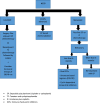Management of Neuroendocrine Breast Carcinoma (NEBC): Review of Literature
- PMID: 38404967
- PMCID: PMC10884130
- DOI: 10.3389/or.2024.12114
Management of Neuroendocrine Breast Carcinoma (NEBC): Review of Literature
Abstract
Extra pulmonary high-grade poorly differentiated neuroendocrine carcinomas (EP-NECs) are rare tumors that usually arise in the gastrointestinal and genitourinary tracts. Primary neuroendocrine carcinoma of the breast (NEBC) is extremely rare, representing less than 0.1% of all breast cancers and less than 1% of neuroendocrine neoplasms. Consequently, they can be misdiagnosed as other types of breast cancer, however, proper immunohistochemical (IHC) studies can assist with making the correct diagnosis. Management of NEBC can be challenging given the paucity of evidence-based literature and should not routinely follow the therapeutic guidelines of other breast cancers. In this article, we review the current literature regarding the management of NEBC.
Keywords: breast; carcinoma; management; neuroendocrine; review.
Copyright © 2024 Mohamed, Zeidalkilani, Asa, Trybula and Montero.
Conflict of interest statement
The authors declare that the research was conducted in the absence of any commercial or financial relationships that could be construed as a potential conflict of interest.
Figures



Similar articles
-
Routine Screening Mammogram Leading to the Incidental Diagnosis of a Metastatic Neuroendocrine Breast Cancer (NEBC) from an Unrecognized Asymptomatic Small Bowel Neuroendocrine Tumor.Cureus. 2022 Mar 18;14(3):e23302. doi: 10.7759/cureus.23302. eCollection 2022 Mar. Cureus. 2022. PMID: 35449642 Free PMC article.
-
Primary neuroendocrine carcinomas of the breast and neuroendocrine differentiated breast cancers: Relationship between histopathological and radiological features.Eur J Radiol. 2022 Feb;147:110148. doi: 10.1016/j.ejrad.2021.110148. Epub 2022 Jan 4. Eur J Radiol. 2022. PMID: 35007984
-
Neuroendocrine Differentiated Breast Cancer Cases: A Retrospective Analysis and Literature Review.Sisli Etfal Hastan Tip Bul. 2021 Dec 29;55(4):503-509. doi: 10.14744/SEMB.2021.66503. eCollection 2021. Sisli Etfal Hastan Tip Bul. 2021. PMID: 35317367 Free PMC article.
-
Neuroendocrine breast carcinoma: a rare but challenging entity.Med Oncol. 2020 Jul 25;37(8):70. doi: 10.1007/s12032-020-01396-4. Med Oncol. 2020. PMID: 32712767 Free PMC article. Review.
-
Neuroendocrine Cancer of the Breast: A Rare Entity.J Clin Med. 2020 May 13;9(5):1452. doi: 10.3390/jcm9051452. J Clin Med. 2020. PMID: 32414120 Free PMC article. Review.
Cited by
-
Multi-omic profiling of breast tumor microenvironment uncovers a role of mitochondrial calcium gatekeepers.J Cancer. 2024 May 13;15(12):3663-3674. doi: 10.7150/jca.95979. eCollection 2024. J Cancer. 2024. PMID: 38911376 Free PMC article.
-
Organoids as a model system for researching human neuroendocrine tumor of the breast.Cancer Cell Int. 2024 Dec 27;24(1):433. doi: 10.1186/s12935-024-03621-w. Cancer Cell Int. 2024. PMID: 39731167 Free PMC article.
-
CDK4/6 and aromatase inhibitors as first-line treatment in metastatic high-grade neuroendocrine carcinoma of the breast: A case report.Clin Case Rep. 2024 Jul 16;12(7):e9180. doi: 10.1002/ccr3.9180. eCollection 2024 Jul. Clin Case Rep. 2024. PMID: 39021492 Free PMC article.
-
Neuroendocrine neoplasms of the breast: a review of literature.Virchows Arch. 2024 Aug;485(2):197-212. doi: 10.1007/s00428-024-03856-y. Epub 2024 Jul 9. Virchows Arch. 2024. PMID: 38980337 Free PMC article. Review.
References
-
- Feyrter F, Hartmann G. On the Carcinoid Growth Form of the Carcinoma Mammae, Especially the Carcinoma Solidum (Gelatinosum) Mammae. Frankf Z Pathol (1963) 73:24–39. - PubMed
-
- Vogler E. Uber das Basilare Helle-Zellen-Organ der Menschlichen Brustdruse. Klinische Medizin; osterreichische Z wissenschaftliche praktische Medizin (1947) 2:159–68. - PubMed
-
- Bocker W. WHO Classification of Breast Tumors and Tumors of the Female Genital Organs: Pathology and Genetics. Verh Dtsch Ges Pathol (2002) 86:116–9. - PubMed
Publication types
LinkOut - more resources
Full Text Sources

